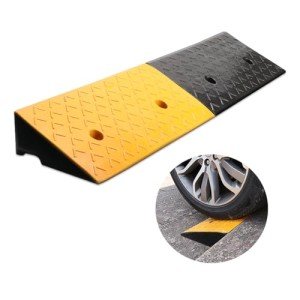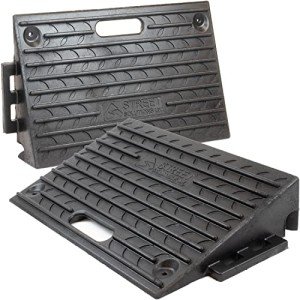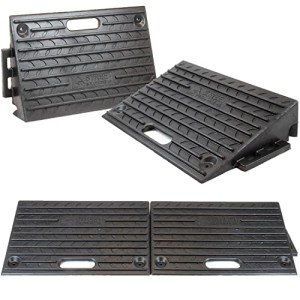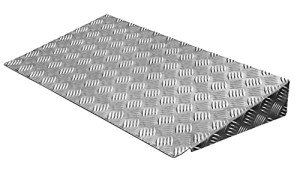In an increasingly mobile world, accessibility has become paramount, particularly for individuals who rely on scooters for transport. Non-slip rubber threshold ramps are essential tools that enhance the practicality of mobility, enabling individuals to navigate various thresholds in their daily lives. This guide delves into the features, benefits, and considerations of non-slip rubber threshold ramps specifically designed for scooters.
Understanding Non-Slip Rubber Threshold Ramps
Non-slip rubber threshold ramps are specifically designed to facilitate the movement of scooters and wheelchairs over transitions such as doorways, curbs, and other raised surfaces. These ramps serve to eliminate obstacles that could otherwise hinder mobility, making it easier for users to travel between different levels safely.
Key Features of Non-Slip Rubber Threshold Ramps
-
Construction: Made from high-quality rubber, these ramps are durable and built to withstand the rigors of continuous use. Rubber provides excellent traction, preventing slips and falls.
-
Dimensions: Available in various widths and heights, these ramps can accommodate different scooter sizes and thresholds. Users can select the appropriate ramp based on their specific requirements.
-
Weight Capacity: Most non-slip rubber ramps boast a high weight capacity, ensuring they can support heavy scooters and their users without bending or collapsing.
-
Portability: These ramps are generally lightweight, making them easy to transport. This feature is beneficial for users who need a ramp at multiple locations.
-
Installation: Designed for easy setup, many rubber threshold ramps require no tools for installation. They can be placed directly at the threshold, making them user-friendly.
-
Weather Resistance: Rubber is inherently resistant to weather conditions, meaning these ramps can be used both indoors and outdoors without fear of deterioration.
The Benefits of Using Non-Slip Rubber Threshold Ramps
Integrating non-slip rubber threshold ramps into daily routines can offer a myriad of advantages:
1. Improved Accessibility
The primary benefit of a rubber threshold ramp is improved accessibility. They provide a smooth transition over abrupt level changes, ensuring that individuals using scooters can confidently enter or exit buildings or navigate pavements.
2. Enhanced Safety
The non-slip surface of these ramps significantly minimizes the risk of accidents and injuries, particularly in wet or slippery conditions. This safety feature is especially vital for older adults and those with mobility challenges.
3. Increased Independence
By removing physical barriers, non-slip rubber ramps empower individuals to move freely without relying on assistance. This independence can greatly enhance the quality of life for those who require mobility aids.
4. Cost-Effectiveness
Compared to constructing permanent ramps, investing in non-slip rubber threshold ramps can be a more affordable option. Since they are portable, they can be used at various locations, providing value for money.
5. Versatile Use
These ramps are not just limited to scooters; they can also support wheelchairs, mobility carts, and even small vehicles when necessary. This versatility makes them a practical investment.
How to Choose the Right Non-Slip Rubber Threshold Ramp
When selecting a non-slip rubber threshold ramp for scooters, several factors should be considered:
-
Height and Angle: Measure the height of the threshold you need to overcome and choose a ramp with the appropriate incline. A gentler slope is often easier and safer to navigate.
-
Width: The ramp should accommodate the width of your scooter to ensure stability. It’s advisable to select a ramp that is slightly wider than the scooter itself.
-
Weight Capacity: Always check the manufacturer's specifications to ensure the ramp can handle the combined weight of the scooter and user.
-
Portability: If you plan to use the ramp in multiple locations, consider its weight and ease of transport.
-
Surface Texture: Ensure that the ramp has a sufficient non-slip texture to provide adequate grip.
Installation and Maintenance Tips
Proper installation and regular maintenance of non-slip rubber threshold ramps will ensure safety and durability.
Installation Steps:
-
Choose Location: Select the appropriate location and ensure the surface is flat and stable.
-
Position the Ramp: Lay the ramp down starting from the beginning of the threshold. Make sure it’s securely in place.
-
Test Stability: Before using, check for stability by applying weight to the ramp. Ensure it does not shift or wobble.
Maintenance Tips:
-
Regular Cleaning: Keep the ramp clean and free from debris to maintain its non-slip surface. Use soap and water, avoiding harsh chemicals that may degrade the rubber.
-
Inspect for Damage: Regularly check for cracks or wear, especially if the ramp is used frequently. Replace if needed.
-
Seasonal Considerations: In winter, clear snow and ice from the ramp to prevent slipping.
FAQs
1. Can non-slip rubber ramps be used outdoors?
Yes, non-slip rubber threshold ramps are designed to be weather-resistant, making them suitable for outdoor use.
2. Are these ramps adjustable in height?
Most rubber threshold ramps are not adjustable in height, so it is crucial to measure the threshold height before purchasing.
3. Will the ramp damage my floor or threshold?
High-quality rubber ramps are designed to be gentle on surfaces. However, it’s advisable to monitor for any signs of wear or damage where the ramp meets the surface.
4. How do I know if a ramp is safe for my scooter?
Confirm the ramp's weight capacity exceeds the combined weight of the user and the scooter. Also, ensure the ramp provides adequate traction.
5. Can I use a rubber threshold ramp for a wheelchair?
Absolutely! Non-slip rubber threshold ramps are versatile and can be used for scooters, wheelchairs, and mobility carts.
Non-slip rubber threshold ramps are invaluable for individuals relying on scooters for mobility, offering safety, accessibility, and independence. Understanding the features and benefits of these ramps facilitates informed decisions, enabling smoother transitions over thresholds and curbs. With the right non-slip ramp in place, users can confidently navigate their environments, enjoying a better quality of life.







